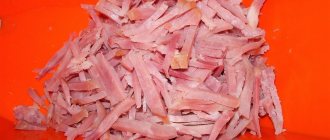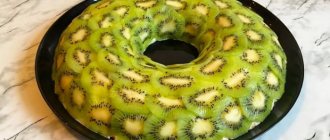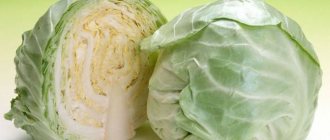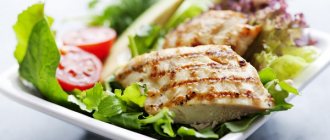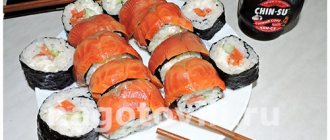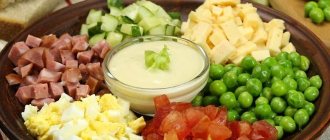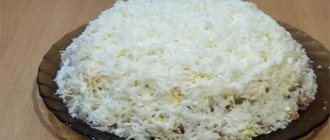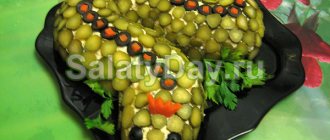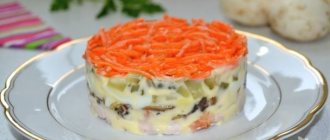Home Vegetable salads
Cooked vegetable salad is a wonderful blend of plant flavors and textures. It's a colorful addition to any dish that can be prepared all year round. Boiled vegetable salads are an excellent side dish.
There are several ways to prepare vegetables, and there has been a lot of debate about which is the best and healthiest. Boiling vegetables is often considered one of the best ways to prepare them because it uses less fat. Cooked vegetables are easier on the stomach as they are easier to digest.
Thanks to a few chefs and other vegetarian recipe enthusiasts, salads have begun to evolve from a side appetizer to a main dish. You can combine a lot of things with boiled vegetables. Ricotta, mushrooms, feta, sundried tomatoes, bell peppers, parsley, tarragon and garlic - these ingredients can be used to create a number of stellar dishes with boiled vegetables.
Sauces and dressings are also very extensive in this type of dish: yogurt-based sauces, balsamic vinegar, cold-pressed oils, cherry vinegar, herbs and warm spices.
For a vegetable salad, choose the best of seasonal vegetables: they will be fresher and it will also be easier on the budget.
How to prepare a salad from boiled vegetables - 15 varieties
- Simple salad of boiled vegetables “Vegetable Cake”
- Salad of boiled vegetables and green beans
- Boiled vegetable salad “Tenderness”
- Salad of boiled vegetables with sesame seeds
- Boiled vegetable salad for every day
- Salad of boiled vegetables and walnut oil
- Salad of boiled winter vegetables with eggs and beans
- Boiled Vegetable Salad with Chilean Oil
- Boiled carrot salad
- Salad of boiled carrots and beans with honey dressing
- European salad and boiled vegetables with egg and beans
- French salad of boiled potatoes and green beans
- Boiled beetroot and feta salad
- Polish salad of boiled vegetables
- Salad of boiled vegetables with shrimps
Beetroot salad - several options
Perhaps the simplest salad that can be prepared at any time of the year, and it will always hit the spot, is a boiled beet salad. Why? Yes, because there are a lot of recipes for such salads - based on beets, and beets themselves are exactly the vegetable that is always available - not from your own garden, but from a nearby store.
Before you prepare a salad from boiled beets, you, of course, need to prepare them - boil, peel and cut them. We do the preliminary preparation according to all the rules - wash the beets thoroughly, preferably with a brush, without cutting off the tip and top. Why? Otherwise, it will lose a lot of useful substances and bright rich color. Place the washed beets in a pan with hot water and cook until tender. To make the beets cook faster, some cookbooks advise boiling the beets until half cooked, then drain the water and refill with cold water. This way the beets will cook much faster. Peel the finished beets by cutting off the ends. In salads, beets are most often either cut into thin cubes or grated on a coarse grater. Boiled beet salad is almost ready - beets grated on a coarse grater, seasoned with salt and mayonnaise or vegetable oil - the simplest salad, and it’s called “couldn’t be simpler.”
This beet salad can be diversified by adding a clove of garlic, passed through a press or finely chopped, to the grated beets. You can also add finely chopped pickled cucumbers or salted or pickled mushrooms.
Boiled beet salad can be supplemented with boiled carrots and potatoes. And if you add salted herring cut into small pieces to these ingredients, laying the salad in layers, you will get a classic “fur coat herring”.
Boiled beet salad is useful for everyone, including those who are on a diet for weight loss, those who are fasting, and those who are subject to dietary restrictions for medicinal reasons.
Simple salad of boiled vegetables “Vegetable Cake”
Traditional and everyone's favorite holiday salad of boiled vegetables.
Ingredients:
- Potatoes - 3 pcs.
- Beetroot - 1 pc.
- Carrots - 2 pcs.
- Onion - 1 pc.
- Pickled cucumbers - 3 pcs.
- Egg - 2 pcs.
- Mayonnaise - 120 g
Preparation:
Boil carrots, eggs, beets. Clear everything. Grate carrots and beets.
Finely chop the eggs.
Finely chop the cucumbers and onions.
Lay out the salad in layers, brushing each layer with mayonnaise. The last layer should be beets.
The salad should soak in the refrigerator for about 2 hours before serving.
Preparation
To prepare a salad from fresh and boiled vegetables, you need to prepare all the ingredients in advance.
- Wash and peel the potatoes, carrots and celery. Boil the vegetables and cut into medium-sized cubes.
- Peel the green apple and remove the core. Cut into cubes. Finely chop the onion.
- Mix all ingredients in a convenient container. Add green peas, stir. Salt and pepper the dish to taste. Finish preparing a salad from fresh and boiled vegetables with dressing.
- Mix mayonnaise with tomato sauce. Add to ingredients. Mix thoroughly and let it brew.
Salad of boiled vegetables and green beans
boiled vegetables are often served as an accompaniment to some meat dishes. They are also added to soups and noodles and are considered "healthy". An easy to prepare and nutritious salad with crispy beans, perfect as a side dish.
Ingredients:
- Green beans - 100 g
- Potatoes, peeled and cut into slices - 200 g
- Carrots, cut into pieces - 100 g
- Olive oil – 23 ml
- Lemon juice, freshly squeezed - 1/4 lemon
- Salt
Preparation:
Prepare green beans by boiling for about 8 minutes.
Boil potatoes and carrots.
Cut the vegetables into small cubes, then place in a large bowl.
In a small bowl, combine oil and lemon juice. Mix and pour sauce over vegetables, season with spices.
The importance of vegetable dishes in the diet is not only in their calorie content, but also in the fact that they are a source of biologically active substances (vitamins, enzymes, phytoncides, etc.) and mineral salts (macro- and microelements), stimulate appetite and have beneficial affect the digestive processes.
Vegetables are a source of vitamins; they cover the human body’s need for vitamin A due to carotene, and contain vitamins B1 and B2. And vegetables such as cabbage, nettle, spinach are an important source of vitamin K. Most vegetable dishes are dominated by alkaline ash elements (potassium, sodium, calcium, etc.), and therefore these dishes help maintain acid-base balance in the body, since in meat, cereals, legumes and flour products are dominated by acidic elements. Vegetable dishes are a source of microelements - cobalt, copper, manganese, etc. Of particular value in this regard are beets, complex vegetable dishes and side dishes: vegetables in milk sauce, vegetable stew, complex side dishes. Some of the mineral salts pass into the broth when vegetables are cooked and especially when they are released. Therefore, vegetable decoctions should be used to prepare soups and sauces. Dishes made from green vegetables (green legumes, lettuce, green onions, parsley, spinach, etc.) are of great importance. They contain a number of substances that have a beneficial effect on the walls of blood vessels, strengthen them and make them more elastic.
Processes that occur during heat treatment of vegetables
When vegetables are cooked, profound physical and chemical changes occur. Some of them play a positive role (softening vegetables, gelatinization of starch, etc.), improve the appearance of dishes (formation of a golden brown crust when frying potatoes); other processes reduce nutritional value (loss of vitamins, minerals, etc.), cause color changes, etc.
One of the changes is the softening of vegetables when cooked. During heat treatment, fiber remains virtually unchanged. Themicellulose fibers swell but remain intact. The softening of the tissue is due to the breakdown of protopectin and extensin.
Protopectin is a pectin polymer that has a complex branched structure. When heated, an ion exchange reaction occurs in the middle plates of protopectin, as a result of which protopectin breaks down to form water-soluble pectin, which causes the softness of vegetable tissues.
Plant products contain phytin and a number of other substances that bind calcium. However, the binding of calcium (magnesium) ions does not occur in an acidic environment, so the softening of vegetables slows down. In hard water containing calcium and magnesium ions, this process will also take place slowly. As the temperature rises, the softening of vegetables accelerates. In addition, the softening of vegetables is associated not only with the breakdown of protopectin, but also with the hydrolysis of extensin. Its content decreases significantly when vegetables are cooked. Thus, upon reaching culinary readiness, about 70% of the extensin in beets breaks down, and about 40% in parsley.
During the heat treatment of potatoes, the starch grains located inside the cells are gelatinized due to the cell sap. In this case, the cells are not destroyed, and the paste remains inside them. In hot potatoes, the connection between individual cells is weakened due to the breakdown of protopectin and extensin, so when rubbed they are easily separated from each other, the cells remain intact, the paste does not leak out, and the puree turns out fluffy. When cooled, the connection between the cells is partially restored, they are separated from each other with great difficulty, their shells tear when rubbed, the paste flows out, and the puree turns out sticky.
When frying potatoes and other starchy vegetables, the surface of the cut pieces quickly dehydrates, the temperature in it rises above 120 ° C, while the starch breaks down to form brown pyrodextrins, and the product becomes covered with a golden brown crust.
When cooking vegetables, some of the sugars (mono- and disaccharides) go into the broth. When frying vegetables, baking onions, carrots for broths, caramelization of the sugars they contain occurs. As a result of caramelization, the amount of sugar in vegetables decreases, and a golden brown crust appears on the surface. The reaction of melanoidin formation, accompanied by the appearance of dark-colored compounds - melanoidins, also plays an important role in the formation of a crispy crust on vegetables.
The different colors of vegetables are caused by pigments (coloring substances). When cooked, the color of many vegetables changes. The color of beets is determined by pigments - betanins (red pigments) and betaxanthins (yellow pigments).
Yellow pigments are almost completely destroyed when beets are cooked, and red pigments partially (12-13%) pass into the decoction and are partially hydrolyzed. The degree of change in beet color depends on a number of factors: heating temperature, betanin concentration, pH of the medium, contact with atmospheric oxygen, the presence of metal ions in the cooking medium, etc. The higher the heating temperature, the faster the red pigment is destroyed. The higher the concentration of betanin, the better it is preserved. Therefore, it is recommended to boil beets in their peels or stew them with a small amount of liquid. In an acidic environment, betanin is more stable, so vinegar is added when cooking or stewing beets.
Vegetables with a white color (potatoes, white cabbage, onions, etc.) acquire a yellowish tint when cooked. This is explained by the fact that they contain phenolic compounds - flavonoids, which form glycosides with sugars. During heat treatment, glycosides are hydrolyzed to release an aglycone, which is yellow in color. The orange and red color of vegetables is due to the presence of carotenoid pigments: carotenes - in carrots, radishes; lycopenes - in tomatoes; violaxanthin - in pumpkin. Carotenoids are stable during heat treatment. They are insoluble in water, but highly soluble in fats; this is the basis for the process of extracting them with fat when sautéing carrots and tomatoes.
The pigment chlorophyll gives vegetables their green color. It is found in chloroplasts enclosed in the cytoplasm. During heat treatment, cytoplasmic proteins coagulate, chloroplasts are released and the acids of the cell sap interact with chlorophyll. As a result, pheophytin is formed, a brown substance.
To preserve the green color of vegetables, a number of rules should be followed:
- boil them in a large amount of water to reduce the concentration of acids;
- do not cover the dishes with a lid to facilitate the removal of volatile acids with steam;
- reduce the cooking time of vegetables by immersing them in boiling liquid and not overcooking them.
During heat treatment, vitamins undergo significant changes. Vegetables are the main source of vitamin C in human nutrition. It is highly soluble in water and very unstable when heat treated. Oxidation of vitamin C occurs in the presence of oxygen. The intensity of the process depends on the heating temperature of the vegetables and the duration of heat treatment. To reduce contact with oxygen, vegetables are cooked with the lid closed (except for green-colored vegetables); the volume of the container must correspond to the weight of the vegetables being boiled; in case of boiling, do not add cold, unboiled water. The faster vegetables are heated during cooking, the less ascorbic acid is destroyed. Therefore, overcooking of food, long-term storage of food is not allowed, and reheating of ready-made dishes is undesirable.
Some substances contained in food products pass into the decoction and have a stabilizing effect on vitamin C. These substances include proteins, amino acids, starch, vitamins A, E, B6, pigments - flavones, anthocyanins, carotenoids. For example, when boiling potatoes in water, the loss of vitamin C is about 30%, and when cooking in meat broth, vitamin C is almost completely preserved. During cooking, ascorbic acid is not only destroyed, but also partially turns into a decoction. Therefore, vegetable decoctions are recommended for use in the preparation of soups and sauces. When frying vegetables, there is less loss of vitamin C, since the layer of fat on the surface of the product reduces contact with air oxygen. Large losses of vitamin C occur when products are subjected to repeated heat, rubbed, and whipped.
When cooked, B vitamins are partially transferred to the decoction and partially destroyed. Vitamin B6 is the least resistant to heat. When cooking spinach, about 40% of it is destroyed, potatoes - 27-28%. The more water for cooking, the less vitamins remain in the product. Frying and stewing vegetables causes the destruction of about 40% of vitamin B2.
During the cooking process, the mass of vegetables changes as a result of two opposing processes:
- due to swelling of hemicellulose and starch, the mass increases;
- After draining the broth, part of the moisture evaporates, which leads to a decrease in mass.
Weight loss also depends on the structural features of vegetables. Moisture losses determine the yield of finished products and therefore the maximum permissible weight losses are regulated by regulatory documents.
Based on the amount of weight loss during cooking, all vegetables can be divided into two groups:
- losses up to 10% (kohlrabi, cauliflower, white cabbage, turnips, parsley, beets, carrots, potatoes);
- losses up to 50% (spinach, sorrel, beet tops, onions, zucchini, squash).
It is easy to notice that the greatest weight loss occurs in leafy vegetables and fruits: the former have a large surface area, the latter contain many air inclusions in the parenchyma tissue in the form of small bubbles. When cooking unpeeled vegetables, the soluble substances are almost completely preserved. When peeled root vegetables (carrots, beets, etc.) are cooked, 20-25% of the substances they contain, mainly sugars and minerals, pass into the water. The content of potassium, sodium, magnesium and phosphorus compounds is significantly reduced. When adding table salt, the loss of a number of minerals is reduced, so vegetables (with the exception of carrots and beets, which contain a significant amount of sugar) are placed in salted water. [7], [8]
Features of cooking vegetables
Vegetables (except beets and green peas) intended for preparing boiled dishes are placed in a cauldron with boiling salted water (10 g of salt per 1 liter of water) and boiled at low boil. With this mode of heat treatment, the loss of nutrients is reduced and vitamins are not destroyed so quickly. Beets and green peas are boiled in unsalted water, as salt lengthens the cooking process and gives the beets an unpleasant taste. When cooking vegetables, the water level should be 1-1.5 cm higher than the level of vegetables, since excess water increases the loss of nutrients.
For preservation, bean pods, peas, spinach leaves, asparagus, artichokes are boiled in a large amount of boiling water (3-4 liters per 1 kg of vegetables) in an open container. The remaining vegetables are cooked with a lid on the container to reduce the oxidation of vitamin C. When steaming vegetables, the loss of nutrients is significantly reduced. Potatoes and carrots, skinned and peeled, are most often steamed. Peeled potatoes are sprinkled with salt. Enough water is poured into the boiler to fill the space under the grate or under the bottom of the mesh pan. When the water boils, place vegetables on a wire rack or in a mesh pan, close the lid tightly and cook until softened. Potatoes of some varieties are overcooked, soaked in water and tasteless. Cutlets, purees, and croquettes made from these varieties also turn out tasteless. Therefore, it is better to use such potatoes for frying. If you have to cook, then the water should be drained before the potatoes are cooked, i.e. 15 minutes after boiling, and finish steaming, covering the container with a lid.
Peeled potatoes should be boiled in such quantity that can be sold within an hour. This is explained by the fact that some oxidizing agents contained in potatoes are not destroyed during heat treatment and continue to act in boiled potatoes. As a result, during long-term storage of boiled potatoes, vitamin C is destroyed and taste deteriorates.
Beets and carrots for cold dishes are cooked whole, unpeeled. It must be remembered that during further cleaning of boiled root vegetables they become heavily contaminated with microbes. Therefore, when preparing dishes from them, sanitary rules should be carefully observed. The stability of beet anthocyanins depends on their concentration: the more concentrated the solution, the more stable these dyes are; when boiled in a small amount of water, the color is preserved better.
Canned vegetables (green peas, sweet corn, asparagus, cauliflower, etc.) are heated together with the broth. Freshly frozen vegetables, without defrosting, are placed in boiling water and cooked for 10-15 minutes. Dried vegetables and mushrooms are washed before cooking, poured with cold water and after 1-3 hours boiled in the same water without salt. [10], [12], [13]
In spinach and sorrel, when boiled in water, up to 80% of ascorbic acid is destroyed, and in Brussels sprouts, kohlrabi, and tomatoes, it is almost completely preserved. Carotene contained in vegetables is preserved very well during heat treatment and only in some cases its content is reduced by 10-20%. B vitamins are destroyed slightly during the heat treatment of vegetables, but a large amount of them can turn into a decoction, into which some of the sugar, minerals, and acids pass. In raw vegetables, the diffusion of substances dissolved in cell sap is difficult, since protoplasm lines the inner surface of the cell membrane, and this membrane itself is poorly permeable. During the heat treatment of vegetables, protoplasmic proteins coagulate and the impenetrable membrane formed by it is destroyed. In addition, the strength of the cell membranes decreases and the permeability of the cell membranes increases, this facilitates the diffusion of cell sap substances and leads to significant losses of nutrients, especially when boiled in water. When steaming vegetables, the loss of nutrients is much less. It is especially important that when cooking vegetables, mainly alkaline nutrients are extracted, which are necessary to maintain the acid-base balance of the body. Cooking vegetables in salt water sharply reduces the diffusion of sodium potassium salts. The softening of vegetables during heat treatment is caused by the hydrolysis of protopectin, which forms connecting plates that hold individual cells together. During heat treatment, protopectin disintegrates, and the strength of intercellular adhesion decreases by 10-12 times. Prolonged cooking leads to complete leaching of soluble pectin and disintegration of the tissue into individual cells. The rate of protopectin hydrolysis decreases sharply as the moisture temperature decreases; for example, decreasing the temperature from 100 to 95 °C slows down the hydrolysis of protopectin by 1.5 times. The reaction of the environment affects hydrolysis differently in different vegetables. The higher the acidity of the medium, the slower the protopectin of carrots, beets, and cabbage hydrolyzes and the harder their consistency.
The range of boiled vegetable dishes includes:
- potatoes in milk - potatoes do not boil well in milk, so first boil them in water for 10 minutes, then drain the water, pour hot milk over the potatoes and cook until tender. Season it with butter, mix with flour, heat it up, put a piece of butter on top;
- mashed potatoes - potatoes are peeled, boiled and dried, rubbed in a mashing machine or through a sieve, avoiding contact with metal. Wipe the potatoes hot, otherwise the puree will be sticky and viscous, as the cell membranes rupture and starch paste flows out of them. Add butter or margarine and hot milk to the mashed potatoes and mix thoroughly. Dispense the puree with butter or margarine;
- Boiled artichokes - processed artichokes are tied with a thread around and crosswise, placed in boiling salted water, acidified with citric acid, and boiled. When the bottom, thickest part of the artichokes becomes soft, they are removed from the water and placed upside down to drain. When serving, the thread is removed, the artichokes are placed on a plate bottom down, and decorated with herbs. Hollandaise or sweet egg sauce is served separately;
- boiled asparagus - boil in boiling salted water until cooked, tied in bunches so that it does not break. The cooked asparagus is untied and placed on a cupronickel plate or small plate. Decorate with sprigs of parsley.
Some restaurants use a special porcelain or nickel silver stand to serve asparagus. It is placed on a cupronickel plate, covered with a linen napkin, the boiled asparagus is placed on a napkin and covered with the edges of the same napkin, decorated with sprigs of parsley.
Asparagus is served separately with sauces - egg-butter with whipped cream, egg-butter, rusk or egg-sweet. Sometimes asparagus is served in milk sauce. To do this, before cooking, it is cut into pieces 2-3 cm long. Boiled asparagus is seasoned with milk sauce and served in a frying pan or in a lamb, sprinkled with oil.
Poached vegetables
Poach vegetables in their own juice or with a small amount of liquid; the resulting broth is not drained, but used together with vegetables. Thus, during poaching, the loss of nutrients is much less than during cooking, and they are reduced only to the partial destruction of vitamins and enzymes. To prepare dishes, you can use certain types of vegetables (turnips, carrots, rutabaga, pumpkin, zucchini, spinach, lettuce, sorrel, kohlrabi) or mixtures thereof. However, spinach should not be stewed together with sorrel, since the acid contained in sorrel causes the spinach to become tough and its color to change. Root vegetables are cut into cubes measuring about 1 x 1 x 1 cm, and zucchini and pumpkin - 3 x 3 x 3 cm, cabbage is cut into large slices or scalded, disassembling it into separate leaves: they are rolled into small balls. Pumpkin, zucchini, tomatoes and other vegetables that easily release moisture are simmered without liquid, and beets, cabbage, carrots - with the addition of liquid (15-20% of the weight of vegetables). Simmer vegetables in a sealed container until cooked. Prepared vegetables are seasoned with oil or medium-thick milk sauce. Poached vegetables are used as an independent dish and as a side dish.
Serving dishes of boiled and stewed vegetables
Steamed and boiled vegetables are used as an independent dish, as a side dish or semi-finished product for making soups, vegetable cutlets, cold dishes, and minced meat.
Ready-made vegetable masses and products made from them must meet the following requirements: homogeneous consistency, without pieces of ungrated food, tender, for mashed potatoes - fluffy, color characteristic of vegetables, without dark inclusions, taste and smell of vegetables with the aroma of milk, butter, not allowed the smell of burnt milk, souffles (puddings) have a delicate and fluffy consistency, the products retain their shape.
Most often, mashed potatoes are used as a side dish for meat and fish dishes. You can serve mashed potatoes as a separate dish with sautéed onions, boiled chopped eggs, mixed with melted butter and sprinkled with finely chopped herbs. Supply temperature 65%.
When serving vegetables poached in milk sauce, they are placed in a heated lamb or in a portioned frying pan or on a small plate in a heap, sprinkled with finely chopped parsley or dill on top. You can put a piece of butter on top and serve with croutons. Vegetables are served in milk sauce as a separate dish or as a side dish for natural cutlets made from lamb, veal, and pork.
Boiled vegetable salad “Tenderness”
A very tender salad is a traditional Russian salad, the main ingredient of which is soft boiled potatoes. The combination of the savory flavors of salmon and soft potatoes in a mayonnaise sauce is incredibly nutritious and easy.
Ingredients:
- Canned salmon – 1 can
- Boiled potatoes - 2 pcs.
- Boiled eggs - 3 pcs.
- Sweet and sour apple - 1 pc.
- Sweet onion - 1 pc.
- Mayonnaise
Preparation:
Divide the boiled eggs into whites and yolks, grate them separately.
Grate the potatoes.
Grate the apple too.
Chop the onion.
Mash the salmon with a fork.
Layer the salad in order: potatoes, salmon, onions, mayonnaise, apple, whites, yolks. Decorate with mayonnaise.
Salad of boiled vegetables with sesame seeds
Boiled vegetables are one of the easiest and fastest ways to prepare them. This is something we can do without having to think too much about the preparation. Therefore, this original and warm salad with sesame seeds will always be appropriate.
Ingredients:
- Grated ginger – 2 tbsp.
- Sesame oil
- Fish sauce
- Sugar
- Soy sauce
- Spices
- Green beans – 200 g
- Broccoli – 400 g
- Carrots - 2 pcs.
- Spinach – 1 package
- Peanut
Preparation:
Boil the beans in boiling water for about 7 minutes.
Boil carrots, spinach and broccoli.
Mix all liquid ingredients, sugar, grated ginger and spices.
Mix everything and sprinkle with nuts.
What does it mean?
Quite often the meaning of the culinary term “poaching” is confused with “sautéing”. The method of preparing vegetables by sauteing involves frying them in the form of small chopped particles, this is done with a small amount of oil. Poaching is a cooking procedure in a special way. Cooking food this way means cooking it with a small amount of liquid for a short time. During this process, the vegetables must be covered with liquid.
Poaching is carried out over low heat, and the dish must have a lid that fits tightly. As a result, the vegetables turn out to be completely heated, but not boiled. It is known that products prepared using this method have a brighter, richer taste and are beneficial.
Unlike cooking, the transfer of vitamins and nutrients into the broth does not occur during poaching - they remain in the vegetable. The dish has a natural, pleasant taste. In the culinary industry, this method of cooking is often used for dietary dishes.
Boiled vegetable salad for every day
With this recipe, we can simply let the vegetables cook themselves and then simply chop them and mix them with other ingredients. This is a light and budget salad, available for any table.
Ingredients:
- Boiled potatoes – 2 pcs.
- Boiled beets – 1 pc.
- Fresh cucumber – 1 pc.
- Pickled cucumbers – 3 pcs.
- Green peas
- Green onions
- Parsley and dill
- Oil
Preparation:
Chop boiled vegetables.
Chop all the cucumbers and onions.
Mix everything and season with oil.
Requirements for the quality and presentation of ready-made dishes
- Boiled products included in dishes should be soft, but not overcooked, and retain their cut shape. If these are vegetable cutlets, then they should be oval in shape with an evenly fried surface.
- The taste of a dish made from boiled vegetables should correspond to the natural taste of vegetables: if it is a vegetable stew - slightly spicy, carrot cutlets - sweet, specific for carrots.
- The color and smell of dishes are characteristic of the fresh products from which they are prepared.
- The presentation of dishes should be beautiful and appetizing. When decorating, you cannot use inedible decorations (plastic, etc.).
- You need to decorate dishes immediately before serving, so that the food does not weather and lose its appearance.
The quality of finished dishes can also be determined by taste, color, smell, consistency and appearance.
Salad of boiled vegetables and walnut oil
Incredibly healthy and low-calorie European salad of boiled vegetables, seasoned with nut butter.
Ingredients:
- Broccoli – 1 bunch
- Asparagus - 1 bunch
- Pumpkin – 400 g
- Zucchini - 1 pc.
- Carrots – 300 g
- Beets – 1 pc.
- Walnut oil
Preparation:
Boil pumpkin, beets, carrots, asparagus and broccoli.
Bake the zucchini.
Coarsely chop all vegetables and mix.
Season with oil and spices.
Salad of boiled winter vegetables with eggs and beans
A nutritious salad made from winter-available ingredients with protein in the form of beans and eggs.
Ingredients:
- Potatoes (boiled) - 4 pcs.
- Pickled cucumber - 2 pcs.
- Beetroot (boiled) - 1 pc.
- Red onion - 0.5 pcs.
- Canned beans (small) - 1 can
- Mayonnaise
- Horseradish
- Chicken egg (boiled) - 3 pcs.
Preparation:
Boil beets and potatoes. Cut into cubes.
Chop the cucumber and onion.
Mix everything together with beans.
Add mayonnaise spices.
Cut the eggs into large slices. Place on top.
For dessert!
Salad 10
- Kiwi
- orange
- banana
- grapefruit
- diced canned pineapple
- lemon
It doesn’t matter what fruit you cut and in what proportions. Try to make the cubes approximately the same size, do not cut them too finely, there will be too much juice. Just squeeze the juice out of the lemon. We add the syrup containing pineapples if the salad turns out sour.
Enjoy your gatherings with friends!
More quick recipes:
Even in the summer, we really like salad for children’s meals: cucumbers, tomatoes, cheese (I use sirtaki or fetax) with sour cream. Don't add salt! And sandwiches: on bread with mayonnaise, a slice of cucumber, tomato (next to each other), salt, sprinkle with finely chopped dill. Or on bread, mayonnaise with garlic mixed, with a tomato on top! Classic: cucumbers with sausage and tomatoes with cheese. Microwave with cheese.
1) Salad: a can of beans, a can of corn, kirieshki (preferably with bacon), crush 1 clove of garlic, mayonnaise. You can + sausage, cheese. 2) A can of canned fish (ideally saury, mackerel, sprats), boiled eggs, onions. Chop everything very finely into cubes, mash the fish with a fork and you can use it as a salad, or better yet, as a pate on bread. 3) Salad: fresh cabbage, egg, canned peas, mayonnaise. 4) Village salad: you don’t have to peel the potatoes, wash them well, cut them into slices, put them on a plate, add salt, add water, cover with a plastic bag and microwave for 10 minutes (open carefully, steam!). Cool slightly, chop, add sauerkraut, onion half rings, and maybe some pickled cucumbers. Season with vegetable oil, preferably unrefined.
Boiled Vegetable Salad with Chilean Oil
Nutritious, yet dietary, boiled vegetables soak up the original spicy Chilean oil in this simple salad.
Ingredients:
- Butter – 2 tbsp.
- Garlic, minced – 1 clove
- Lemon zest
- Jalapeño sauce
- Lemon juice – 3 tbsp.
- Broccoli – 300 g
- Carrots – 2 pcs.
- Cauliflower – 300 g
Preparation:
Boil carrots, broccoli and cabbage. Chop and mix.
Mix all other ingredients. Season the mixture of vegetables with the resulting sauce.
Keep in mind that more tender vegetables, such as broccoli, will cook faster than denser vegetables, such as carrots.
What kind of side dish is there?
When serving fish or meat, vegetables should not only complement, but also set off both in color and taste. In vegetarian cuisine, such an additive will be the basis.
A vegetable side dish is an addition to the main dish to increase the portion or improve the taste and quality. He can be:
- consisting of one component;
- from several ingredients;
- combined.
Both raw and heat-treated products can be served as a side dish. A raw vegetable addition is often called a salad, such as coleslaw. According to the method of preparation, the snack is:
- boiled, stewed;
- baked in the oven;
- fried, in the form of puree;
- fresh vegetables cut into pieces.
When choosing an additive for the main dish, you should think about everything down to the slightest nuance. The combination of flavors may be the most unusual, but adding herbs and spices can balance everything out. There are some rules in cooking, but taste is always the basis.
Boiled carrot salad
Boiled carrots contain more beta-carotene than raw carrots. Therefore, this easy-to-prepare, but luxurious and very budget-friendly winter salad will also be incredibly healthy.
Ingredients:
- Carrots - 1 pc.
- Hard-boiled eggs - 2 pcs.
- Onions - 0.5 pcs.
- Green peas, frozen - 3 tbsp.
- Mayonnaise - 3 tbsp.
Preparation:
Boil carrots and eggs. Grate.
Grate the onion as well.
Grating the onion will minimize its bitterness in the salad.
Mix all ingredients, including peas and mayonnaise.
Sewing
There is also another interesting technique for preparing vegetables (not only them, you can do meat, fish, anything) - poaching. This is slow simmering in liquid, I do it in oil. But I would call this a semi-professional technique, it will require precise temperature control, so you need to know your stove well and be able to maintain a stable temperature on it, and you will need a thermometer.
Pour 3-4 centimeters of vegetable oil into a deep form, heat it to 80 degrees and throw vegetables, cut into small cubes, into it. And simmer them within 80-95 degrees. For example, carrots, cut into 1×1 centimeter cubes, are cooked in 7-12 minutes at a temperature of 95 degrees. That is, after 7 minutes in oil, you test the readiness with a toothpick and bring it to the desired softness for another 5 minutes. The carrots turn out very juicy and crispy.
The potatoes will take a little longer to cook and contain more starch.
This way you can fry onions, fish, meat. But we must take into account that oil absorbs all odors very well, and if you put the vegetables to be cooked in the same oil where you fried the fish before, then the oil will absorb the aroma and it will be even stronger than if you just put potatoes in one pan after the fish were fried. Therefore, it is better to pour out the oil for fish and cook it separately.
Salad of boiled carrots and beans with honey dressing
A unique salad made from two ingredients, but at the same time capable of satisfying and beneficial.
Ingredients:
- Boiled carrots – 2 pcs.
- Green beans – 400 g
- Honey
- Lemon juice
- Spices
Preparation:
Chop the carrots. Boil the beans.
Mix honey, lemon juice and spices. Season the vegetables with the sauce.
Raw or cooked?
Today there is no single correct decision regarding the consumption of vegetables. Raw food diets and cooked foods also have their fans. Salads made from raw and boiled vegetables are equally tasty and aromatic. You can also combine vegetable salads with boiled beef, chicken and other types of meat. In this case, vegetables can be used in any form.
Another question: how much benefit do certain cooked vegetables bring? There are some that are best eaten raw, while others are better boiled. In the children's menu, it is recommended to use only boiled foods, since the body simply cannot digest heavy raw food.
Scientists and nutritionists have found that when cooked you should eat:
Sometimes you should add variety to your diet and enjoy raw carrots, tomatoes, and onions. Bell peppers, garlic, and cucumbers are also optimal for a raw food diet. All vegetables must be chewed thoroughly. Also, we should not forget about the possibility of preparing freshly squeezed juices and purees.
European salad and boiled vegetables with egg and beans
A French restaurant dish can also easily be homemade since all the ingredients are easy to prepare. This salad also looks very beautiful, so you can safely serve it to guests.
Ingredients:
- New potatoes, boiled – 400 g
- Green beans – 400 g
- Boiled eggs - 4 pcs.
- Shallot – 1 pc.
- Lemon zest
- Lemon juice
- Honey – 1 tbsp.
- Dijon mustard
- Oil
- Spices
- Dill
- Dried capers – ¼ cup
- Radish – 1 bunch
- Olives – 100 g
Preparation:
Boil potatoes, eggs and beans.
Chop the shallots, radishes and dill.
Mix all liquid ingredients, including lemon zest and spices.
Mix everything adding chopped olives and capers.
French salad of boiled potatoes and green beans
Savory little potatoes with a bold, spicy dressing and the addition of eggs in this unique French salad.
Ingredients:
- New potatoes – 300 g
- Bay leaf
- Thyme
- Anchovies – 1 tbsp.
- Garlic – 1 clove
- Capers – 1 tbsp.
- Vinegar
- Mustard
- Olive oil
- Green beans – 200 g
- Eggs – 4 pcs.
- Green onions
- Parsley
- Basil
Preparation:
Boil potatoes and eggs. Cut the eggs in half.
Cut the potatoes into strips.
Boil the beans.
Mix all ingredients.
Alpine flower
In some ways this dish is reminiscent of Olivier, but its taste and appearance are much richer and brighter. To prepare you will need the following set of products:
- Cooked-smoked cervelat - 300 g.
- Potatoes - 3 large tubers.
- Apple - 1 fruit.
- Carrots - 2 root vegetables.
- Large eggs - 4 pcs.
- Sweet bell pepper - 2 fruits.
- Peas - 300 g.
- Parsley - 1 sprig of greenery.
- Mayonnaise.
“Alpine flower” is very simple to prepare. To prepare it, you should follow the following technology:
- Boil the potato tubers and carrots until tender. Cool and clean well.
- Chicken eggs also need to be boiled, cooled and shelled.
- You need to cut the potato tubers into small cubes.
- Chop the cervelat into thin pieces.
- Cut the carrots into medium cubes.
- The eggs are also finely chopped with a knife or egg slicer.
- Red bell pepper is rinsed, freed from seeds and stalks, and then cut into flower petals using a grater. If there is no grater, no need to worry. You can just use a knife.
- It is necessary to cut off the oval plates from the convex parts of the fruit, and the remaining pieces are chopped into small squares.
- The apples are washed, cored and cut into thin strips. This is done before the ingredients are mixed. Otherwise, it will darken and look unattractive.
- You need to drain the liquid from the peas, and then combine all the products in one salad bowl and pour in mayonnaise. Stir well and transfer to a beautiful salad bowl.
To decorate, make a flower out of pepper, and make a stem with leaves out of a parsley branch.
Boiled beetroot and feta salad
Feta cheese and beets are soaked in a delicious and original wine sauce.
Ingredients:
- Brown sugar – 1 tbsp.
- Wine vinegar – 2 tbsp.
- Beets – 1 pc.
- Feta cheese – 100 g
- Olives – 9 pcs.
- Olive oil
- Spices
Preparation:
Boil the beets. Cut into cubes.
Feta cheese also cut into cubes.
Mix all liquid ingredients.
Mix sugar and vinegar with oil and spices.
Season the cheese and beets with sauce. Let it sit in the refrigerator for about 3 hours. Add olives.
Vinaigrette without potatoes
This dish is suitable for those who cannot eat potatoes, or for those who simply do not like them. The composition contains the following products:
- Beet and large carrots - 1 root each.
- Pickled cucumbers - 4 large pieces.
- Sauerkraut - 200 g.
- Sunflower oil and salt.
The method of preparing a salad consists of the following steps:
- Wash the root vegetables well and boil for 60 minutes in salted water. Cool and peel. Cut into medium sized cubes. Place in a container where it will be convenient to mix the products.
- Cucumbers also need to be cut into cubes and placed in a container with root vegetables.
- Drain excess liquid from the sauerkraut and place it with the remaining ingredients.
- Salt and pepper the preparation (optional), then pour in vegetable oil and stir thoroughly.
This recipe can be varied by adding mushrooms and canned peas (can be replaced with beans).
Instead of boiling, you can bake vegetables in the oven. This salad will be tastier and more unusual.
Polish salad of boiled vegetables
This salad is great on its own or can be served with any type of meat. It also makes a great addition to barbecue. Although this creamy salad is similar to potato salad, the emphasis is on other ingredients rather than just the potatoes.
Ingredients:
- Eggs – 5 pcs.
- Pickled cucumbers – 10 pcs.
- Apples – 3 pcs.
- Peas – 1 can
- Carrots – 4 pcs.
- Potatoes – 3 pcs.
- Parsley
- Celery root – 1 pc.
- Mustard
- Mayonnaise
- Spices
Preparation:
Boil eggs, carrots and potatoes. Finely chop everything.
Slice cucumbers and apples. Grate the celery root. Mix all.
Add mustard, mayonnaise, peas and parsley to the salad. Mix everything and leave the salad to soak for 2 hours in the refrigerator.
It is better to boil the vegetables for the salad the day before preparing it.
Herring under a fur coat - the final stage
Boil the vegetables in their skins, cool, peel, and grate. Cut the herring into small pieces, the onion into half rings. Be sure to sprinkle it with salt, sugar, pour in a little vinegar and mix. Leave it for 20 minutes to marinate. Prepare a thick sauce from mayonnaise and mustard, sugar, salt, and vinegar. Place the herring on the dish first, lightly sprinkling it with apple cider vinegar. Then onions. And brush with sauce. Next are the potatoes. Season it with a little salt, sprinkle with ground pepper and also season with sauce. Next is a layer of carrots, and also salt, pepper, sauce. Finally, grate the apple and place immediately. You should not do this in advance, because the apple pulp quickly darkens. You can do without sauce here. The topmost layer is beetroot. Cover it with sauce too, sprinkle with finely chopped green onions or parsley stalks. And put it in the refrigerator for a couple of hours so that all the ingredients are saturated with each other’s juices. It will be delicious, believe me!
